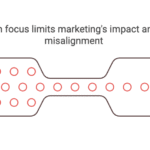
In this article, we are going to discuss how to reduce lag, compress cycles, and move from list to live conversations in hours and not weeks. So, let’s begin!
Outbound performance is often chalked up to copywriting, cadence structure, or persona targeting. But the real differentiator? Speed. A speed-first outbound motion doesn’t just optimize for throughput. It optimizes for timing. Most signals (job changes, funding, tech installs) have a short shelf life. If you wait days to act, you’re irrelevant. The buyer has already talked to someone else, or their urgency has faded.
Top teams don’t just personalize better. They move faster. They go from trigger to touchpoint in under 24 hours, sometimes in less than two. That kind of velocity compounds over time. This guide breaks down the infrastructure, tools, and habits required to build an outbound engine that prioritizes speed without sacrificing quality.
What “Speed-First” Actually Means in Outbound Sales?
Speed-first doesn’t mean rushing blindly or ignoring strategy. It means engineering your GTM system to reduce lag at every step of the outbound workflow.
That includes the time from when a lead is sourced to when they are enriched, from when they are prioritized to when they are actually sequenced, and from the first touch to the first call. This timeline needs to be measured in hours and not days.
The key is identifying lag points and systematically eliminating them. For example, if you’re capturing job change signals daily, but reps don’t call for another three days, that’s a failure of process, not of performance. Track metrics like lead-to-sequence time and signal-to-touch lag to find bottlenecks.
The goal isn’t just speed for its own sake. It’s about maximizing your chances of reaching a buyer while they’re still in motion.
A workflow is fast only when the sum of its micro-delays is low. Track three latency metrics religiously:
| Lag Window | Acceptable Target | Elite Target |
| Signal → Enrichment | < 4 h | < 15 min |
| Enrichment → Sequence | < 8 h | < 30 min |
| First Touch → First Call | < 12 h | < 2 h |
Why Most Outbound Teams Are Slower Than They Think
Many outbound teams think they move fast because reps are busy. But busyness isn’t the same as velocity. Most delays come from workflow inefficiencies that are hidden under layers of manual processes and tool sprawl. Reps often export CSVs, flip between 4–5 tools, copy-paste LinkedIn URLs, and wait on RevOps to push enriched data into the CRM. That’s not speed but that’s latency.
Enrichment workflows that depend on batch exports or overnight runs are another common culprit. A rep sees a new prospect on LinkedIn, submits them for enrichment, and waits 24 hours to get a phone number back.
By then, the signal is cold. Add to this approvals for campaign inclusion, redundant research cycles, and low-confidence routing logic. And what looks like a fast-moving machine is actually grinding in place.
Five silent culprits suck days out of the calendar:
- Batch Everything Culture
- Weekly CSV pulls, Friday list uploads, Monday morning sequence kicks.
- Result → Signals collected Tuesday sit idle for six days.
- Enrichment Round-Trips
- Vendor APIs throttle exports; CSMs queue “data pulls.”
- A single “priority” file often takes 24 h before reps see numbers.
- RevOps Bottlenecks
- SDR manager needs to approve tiers; RevOps validates territories.
- Governance is important, but linear sign-off chains kill velocity.
- Research Paralysis
- Reps spend 15–20 min per contact Googling trivia for deep personalization.
- At 40 touches/day, half the shift vanishes into tab-bing.
- Tool Sprawl
- Six browser tabs per action = cognitive latency.
- High intent fades while reps copy-paste between platforms.
Individually harmless, these frictions combine into multi-day drags that your dashboard never surfaces.
The Core Building Blocks of a Speed-First Workflow
A speed-first GTM system is designed for one thing: compression. Every layer of the workflow should minimize delay from data intake to outbound action. It starts with signal ingestion—tools that can detect and trigger on job changes, hiring surges, intent signals, and tech installs in real-time or near-real-time. These signals should then route directly into a dynamic list creation engine.
Next comes enrichment. This must happen in minutes, not hours. Email, mobile, title, and LinkedIn profile should be returned in a format that reps can immediately act on. Then you need a prioritization layer that scores contacts by urgency: combining firmographic fit, recency of signal, and persona relevance.
Once that’s done, the outreach layer needs to kick in. Your sequencing tool must support instant queueing, call-first execution, and follow-up across multiple channels. This stack isn’t just about moving faster—it’s about syncing GTM motion to the rhythm of buyer activity.
Key subsystems:
- Signal Engine: Real-time scraping (PhantomBuster), intent APIs, and webhook feeds push events continuously—not daily.
- Enrichment Core: On-demand services (e.g., Reachfast) returning verified mobile/email in minutes.
- Prioritization Rules: Weights = ICP fit × signal recency × persona buying power.
- Sequencer: Call-first tools (Salesloft, Outplay, Orum) that let reps trigger dial + VM + SMS from one screen.
The enrichment stack is where most teams bleed time and momentum. Traditional enrichment workflows rely on overnight processing, manual mapping, or CSM dependencies.
By the time your rep gets a usable contact, the signal that triggered it has aged out. Instead, you need enrichment tools that operate on-demand and mobile-first.
Reachfast is purpose-built for this. You upload a CSV or drop a LinkedIn URL and receive back verified mobile numbers, email addresses, titles, and LinkedIn profiles. There’s no waiting for bulk processing or account managers to assist.
This turns enrichment from a bottleneck into a bridge. You go from prospect identification to outbound-ready contact in less than ten minutes, which means you can call the right person while the signal is still hot.
Routing is where speed meets strategy. If your reps are sitting on fresh data because routing hasn’t been finalized, you’re wasting valuable time. A speed-first workflow needs automated routing logic that assigns new leads in real time. This includes persona-based ownership rules, territory logic, and capacity load-balancing.
Prioritization must also be dynamic. Not all Tier 1 accounts are equal on all days. A mid-market account with high intent signals today is more valuable than an enterprise logo with no motion.
Build scoring logic that incorporates ICP fit, signal strength, tech stack clues, and past engagement. For example, a Series B startup that hired a VP Sales and adopted Outreach in the same month should get sequenced immediately. Automate this logic and push leads into high-priority SDR queues without delay.
Execution Layer: What a Speed-First Sales Tech Stack Looks Like?
Your execution stack needs to be designed around fast action, not long-term drip. Reps should be able to trigger voice, email, and social sequences within minutes of enrichment.
Tools like Salesloft, Outplay, and Orum make this possible. They support multi-touch cadences with built-in dialers, voicemail drops, and task management that doesn’t force reps to context-switch between platforms.
A speed-first SDR environment also includes real-time content support. Reps shouldn’t be writing every email from scratch. Use AI-generated message starters or modular scripts that personalize on role, company type, and signal.
Everything, from talk tracks to objection handling, should be accessible in one click. Time lost in tab-switching is pipeline lost. Fast execution comes from reducing cognitive load, not just increasing dials.
| Layer | Core Tool | Speed Benefit |
| Dialer | Orum | Multi-line connects ↑ talk-time 2-3× |
| Sequencer | Salesloft | Auto-tasks for call + VM + email without tab-switch |
| Social Touch | Taplio, heyReach | Connection + DM in < 45 sec |
| AI Draft | GPT plug-in, Clay, native-ai of existing tools | 80 % email scaffold → rep edits in 90 sec |
| Knowledge Snippets | Gong content cards | One-click objection handling references |
Daily rhythm: two 90-min call blitz blocks (AM/PM). Reps hammer “Hot Now” queue first, using click-to-dial → voicemail drop → SMS follow-up in under 2 min per contact. Remaining time goes to Tier-2 nurture sequences.
Governance Without Friction: How to Maintain Speed with Accuracy
Speed-first doesn’t mean chaotic. Guardrails ensure quality without bottlenecks. Start with automated filters for job titles, seniority, region, and compliance blocks. These prevent the wrong leads from entering sequences without forcing reps to check manually.
Then implement lightweight QA processes. Instead of approvals, use random sampling of outbound activity. Review 5–10% of weekly activity per BDR/SDR to catch issues and course-correct.
Lastly, use reply reason tracking to audit not just what worked but what went wrong. If 20% of replies are “wrong person,” your routing logic is broken. Maintain speed, but keep feedback loops tight.
Keep compliance light, fast, and after-the-fact
- Skip the “airport-security” checkpoints. Instead of forcing reps to wait for approvals before sending, let them move—and inspect a small sample afterward.
- Auto-exclude the obvious. Sync a nightly “do-not-touch” list from your CRM so current customers, open deals, and special accounts never slip into sequences.
- Filter titles on the fly. A simple rule (regex) blocks contacts with words like “intern,” “assistant,” or “student” so junior names don’t clog call lists.
- Spot-check, don’t bottleneck. RevOps reviews about 10 percent of each rep’s weekly outreach, drops quick Loom feedback in Slack, and fixes issues within a day.
- Tag every reply. Reps label responses– Not a fit, Wrong person, Timing, Interested. If “Wrong person” climbs, fix the data source, not the cadence.
- Track one score. Measure mistakes per 100 contacts. Keep errors under 3 percent while still hitting a “signal-to-dial” window of less than 24 hours.
Mistakes to Avoid
The most common trap is over-personalization. If your reps spend 20 minutes researching a lead before every email, you’ll never scale. Use templates with dynamic snippets that cover 80% of personalization needs. Another error is relying on static lead lists. These go stale fast. Work off dynamic, signal-triggered lead flows that update daily.
Delayed enrichment is a killer. If your enrichment tool takes hours to return phone numbers, you’re already behind. Lastly, avoid stacking too many tools without workflow integration. Every click, tab switch, or login is a speed tax.
Make sure your GTM tools talk to each other and deliver contacts in a ready-to-act format. Here are some classic speed killers that you should purge:
- Craft-Every-Email Syndrome If personalization > 4 min, rep is a copywriter, not a seller.
- “Perfect Data or Bust” Culture Aim for 90 % confidence, enrich gaps after first connect attempt.
- Tool Bloat If a new SaaS adds steps instead of collapsing them, rip it out.
- Weekly Reporting Waits Dashboards auto-refresh hourly; reps shouldn’t wait for Friday roll-ups to course-correct.
- Signal Hoarding Holding lists for “team enablement” sessions neutralizes freshness. Train reps once, let automation flow.
Closing: In 2025, Speed Is a Competitive Moat
Speed doesn’t mean cutting corners. It means removing friction. It means going from signal to sequence before the buyer cools off. The best outbound teams in 2025 aren’t just better writers or louder dialers. They’ve designed workflows that compress lag, automate handoffs, and move reps into conversation mode fast.
Outbound is a timing game. Get to the buyer before they start researching. Call before they reply to your competitor. Sequence while the signal still matters.
Speed doesn’t replace relevance. It multiplies it. Build your GTM engine for speed, and every other part of your pipeline will compound.
And yes, if you need our help, feel free to reach out at nitin@growth9.com.





